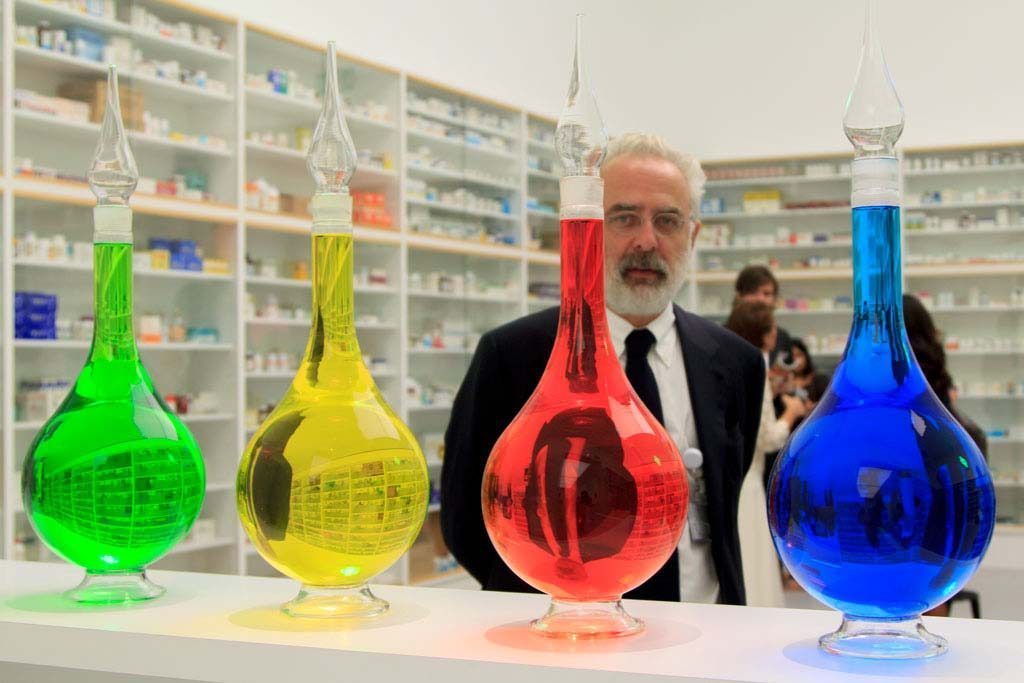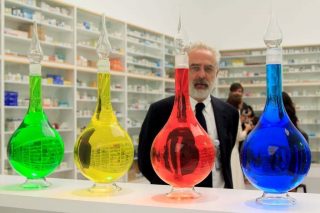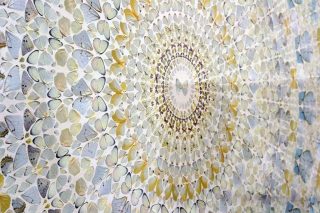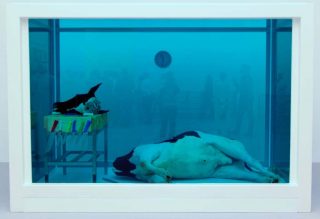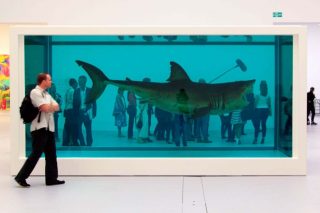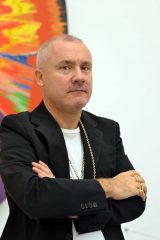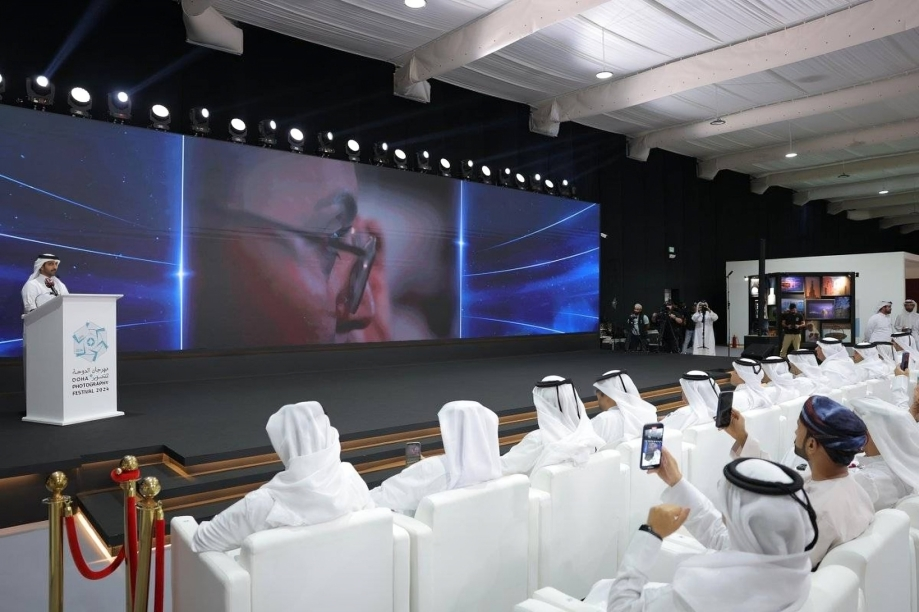Photos by Gazanfarulla Khan
The stench of blood and the rank smell of cigarettes are some of the lingering impressions that stayed with visitors who were given a sneak preview of iconic British artist Damien Hirst’s new retrospective in Qatar today.
The exhibition, Hirst’s largest to date and his first in the Middle East, opens to the public tomorrow at the Museum of Islamic Art’s Al Riwaq Doha gallery.
The 93 pieces on display include two of his most famous artworks – Leviathan, a 6.8 meter (22-foot) shark suspended in a vitrine of turquoise formaldehyde; and For the Love of God, a platinum skull, complete with human teeth, encrusted with diamonds.
A Thousand Years is also on display. That piece is comprised of a pair of connected glass cubes slightly more than two meters high. In one, flies hatch inside a white box. Inside the other, live flies and maggots feed on a severed cow’s head and the stream of blood spilling from it.
An electric insect trap emitting neon-blue light hangs directly above it, with a heap of dead flies piled in its metal basin, closing the symbolic circle of life observers say the piece illustrates.
Another notable work in the exhibition is Lullaby, the Seasons, a piece consisting of four stainless steel medicine cabinets filled with thousands of pills, including one cabinet that was sold to former Emir Sheikh Hamad bin Khalifa Al Thani for a reported $19.2 million in 2007.
Death
Many of Hirst’s pieces are centered around the theme of death intruding into daily life. Speaking to reporters today, he said:
“(Mortality) may fascinate me a bit more than most… The beauty of life is that it can and will be taken away. I was taught when I was young to confront things you can’t avoid. Unfortunately, death is one of those things.”
Speaking to Doha News, exhibition curator Francesco Bonami said that Hirst’s art, while provocative, is intended to go beyond the shock factor:
“(Hirst) tells a story with his work of the simple and complex issues that all of us are facing: life, death, fear, beauty, how we deal with death and decay, luxury and value.”
Bonami added that certain Hirst pieces were omitted from the exhibition because they either didn’t make sense with its overall flow or because the curator deemed them “gratuitous.”
“It is not about shocking (people),” he said. “We’re coming to not just an Islamic culture, but a place where the general public has not been exposed to contemporary art,” which led to one or two pieces – Bonami said he couldn’t recall which ones – being excluded.
The curator added that he and his colleagues made the decision themselves. “We operated in total freedom about the selection.”
Speaking to Doha News, Hirst said he never felt any pressure to omit any of his more controversial pieces from the exhibit. He raised the example of Saint Bartholomew, Exquisite Pain, a 2.5-metre (8-foot) statue of a naked man with a fig leaf obscuring his genitals.
He said the fig leaf was included to avoid any problems with displaying it for a Chinese audience and said that if he really wanted, he would have removed it for the Doha exhibition.
“They seem pretty open-minded here,” Hirst said.
History
Born in 1965 in Bristol, Hirst rose to contemporary art prominence in the late ’80s and early ’90s with his installations of dead animals as well as “spot” paintings – canvas with randomly colored circles – and “spin” paintings featuring colors streaked across a circular surface, several of which are currently rotating on the walls of Al Riwaq.
Hirst is also the artist behind The Miraculous Journey set of 14 statutes showing the progression from conception to life, unveiled earlier this week in front of the under-construction Sidra Medical and Research Center near Education City.
He said he was approached by Qatar Museums Authority chair Sheikha Al Mayassa Bint Hamad Bin Khalifa Al Thani in 2009 about creating a “really special” outdoor project. QMA subsequently sponsored Hirst’s retrospective at the Tate Modern in London in 2012, which preceded the much larger “Relics” in Doha.
Hirst once vowed he’d never display his works in a retrospective exhibit, reportedly telling David Bowie in 1996 that “museums are for dead artists.”
But now, with 25 years’ worth of his art featured in Qatar, Hirst is hoping to achieve a modest hint of immortality among his Doha audience. He said:
“It would be amazing if people could still remember this exhibition a week after they’ve seen it. The worst thing, if you’re an artist, is people saying, ‘Do you remember that exhibition with the shark? What was the guy called?’ It would be nice if they could remember my name as well.”
According to the exhibition’s website, Relics open Thursday at noon. Entry is free and open to the public, and the exhibition will be on through January 2014.
Visitors are invited to share their thoughts on the exhibition online or record a video message at Al Riwaq.
Thoughts?

